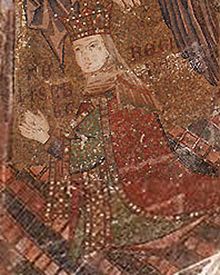Elisabeth of Carinthia
| Elizabeth of Carinthia | |
|---|---|
 |
|
| Queen consort of Sicily | |
| Tenure | 25 June 1337 – 15 August 1342 |
| Born | 1298 |
| Died | 1352 |
| Spouse | Peter II of Sicily |
| Issue |
Louis of Sicily Frederick IV of Sicily Constance of Sicily Eleanor, Queen of Aragon Beatrice, Electress Palatine Euphemia of Sicily Violante of Sicily John of Sicily Blanche, Countess of Amphurias |
| House | House of Gorizia |
| Father | Otto III of Carinthia |
| Mother | Euphemia of Silesia-Liegnitz |
Elizabeth of Carinthia (1298–1352) was an influential queen and royal family member in the Kingdom of Sicily, who lived and ruled in a tumultuous time. In 1323, she married Peter II of Sicily and became the Queen of Sicily. During her time as Queen, Elizabeth ensured that the royal lineage of the Aragonese in Sicily continued. Two sons eventually ascended the throne, Louis of Sicily and Frederick IV of Sicily. Elizabeth was the regent for her young son Louis from 1348 until her death in 1352.
Politically, the decades leading up to Elizabeth's reign were full of conflicts between Frederick III, King of Sicily, and Robert of Naples who had the backing of the papacy in Avignon. Famine, warfare, and plague were widespread in Europe during the mid-fourteenth century, which had a devastating impact on Sicily in particular, due to its economic expansion and prosperity in the two centuries prior. Elizabeth's reign occurred during a period where Italian citizens were disheartened and anxious, which caused tension among the local populace. The island was also marked by turbulent relations between the throne and Sicily's noble families, eventually degenerating into a civil war. These internal rivalries between the noble families required the coming of age of Elizabeth's sons to resolve the fighting.
Understanding Elizabeth of Carinthia's rule in Sicily (1323–52) requires some background information specifically examining the political decision-making of Frederick III, King of Sicily and father of Elizabeth's husband Peter II. In 1282, the Crown of Aragon led by Peter III took Sicily from the Angevins, part of the outcome of the so-called Sicilian Vespers rebellion. In 1295, Pope Boniface VIII insisted that Aragon return Sicily to the Angevins. The Treaty of Anagni was signed by Peter's son James II who was king of both Sicily and Aragon at the time. The treaty promised to withdraw Aragonese troops from Sicily. Frederick III, acting governor of Sicily, however, refused to relinquish control. The Sicilians were more loyal to Frederick than the Angevins and so Frederick was crowned King of Sicily by the people at Palermo in 1296. Frederick also had the support of the local clergy, who were treated poorly by the Angevins, but Sicily had been excommunicated in 1282. Pope Boniface was not pleased about this new king of Sicily, as the Angevins were close allies to the papacy. In response, he declared successive crusades against the Sicilians in 1296, 1299, and 1302. Even with the help of Frederick's brother James, the crusading forces were not able to take back Sicily. This victory for Frederick was cemented in the treaty of Caltabellotta in 1302. The treaty recognized Frederick as the King of Sicily under the condition that his heirs must return Sicily to the Angevins upon his death in exchange for other land. It thereby allowed Sicily to remain under Aragonese rule, attracting settlers and developing trade with Catalonia. Frederick would later change his mind on these conditions, which led to Peter becoming king when he died.
...
Wikipedia
